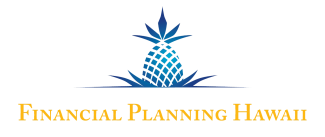
How Will the SECURE Act 2.0 and Other Recent Tax Law Changes Affect you?
How Will the SECURE Act 2.0 and Other Recent Tax Law Changes Affect you?
By J.R. Robinson, Founder, Financial Planning Hawaii & Fee-Only Planning Hawaii (Feb 2023)
The purpose of this article is to raise awareness of the many tax rule changes that were introduced at the end of 2022 that are likely to impact the planning decisions of FPH and FOPH clients.
The first set of changes is the annual inflation indexing adjustments that are introduced by the IRS, Social Security Administration, and Centers for Medicare and Medicaid Services (CMS) at the end of each year. Since inflation has been running hot since the end of 2021, consumers may notice larger than normal increases in Social Security retirement benefits. Contribution limits, including catch-up contribution limits for taxpayers age 50+, for IRA and qualified retirement plan contribution limits all received a healthy boost too. Rather than go over all the annual updates, I encourage you to download the following 2023 tax tables. These are the same “cheat sheets” that I use to keep track of these important metrics.
- Putnam Investments 2023 Tax Rates, schedules & Contribution Limits [ https://www.putnam.com/literature/pdf/II985.pdf ]
- Delaware Life 2023 Tax Information [ https://www.putnam.com/literature/pdf/II985.pdf ]
- College for Financial Planning 2023 Annual Limits Relating to Financial Planning [ https://bit.ly/3xjHUyY ]
Note: There is a fair amount of overlap between these three tables, but each has its own unique information too.
Secure Act 2.0 Details
For its part, the SECURE Act 2.0, which, as its name belies, represents Congress’ efforts to expand upon the tax law changes introduced with the Setting Every Community Up for Retirement Enhancement Act (“SECURE Act”) of 2019. While Secure Act 2.0 is arguably not as impactful as the original, there are many provisions in the new rule that may be relevant to your financial planning situation. Here are some of the highlights:
Secure Act 2.0 RMD Age
The RMD age for IRAs and qualified retirement plans age has been raised to age 73 beginning with the 2023 tax year. Secure Act 2.0 further raises the RMD age to 75 beginning in 2033.
Secure Act 2.0 RMD Rules
Secure Act 2.0 eliminated the RMD rule for qualified plan Roth accounts. This change brings Roth account rules for employer-sponsored plans into consistency with rules for Roth IRAs, which have never been subject to RMDs (except for inherited Roth IRAs).
Secure Act 2.0 Roth Conversion
Secure Act 2.0 creates Roth accounts for SEP and SIMPLE small business retirement plans. This change brings these popular plans into consistency with 401(k) plans. Similarly, the new Roth Rules permit employer qualified plan contributions to be made into after-tax Roth accounts too. Such after-tax contributions will be reportable as taxable income on plan participant’s tax returns.
Secure Act 2.0 Catch-Up Contributions
Secure Act 2.0 requires age 50+ catch-up contributions for high wage earners (defined as wage-earners making more than $145,000 (indexed for inflation)) to be made to after-tax Roth accounts. This is a significant change and is probably the most underpublicized feature of Secure Act 2.0. Interestingly, since Roth accounts are an optional feature on 401(k) plans, age 50+ higher earners will still be able to make pre-tax catchup contributions if their existing plan does not permit after-tax Roth contributions.
Secure Act 2.0 529 Plan Changes
Secure Act 2.0 allows wage-earners with unused 529 plan balances to transfer as much as $35,000 to Roth IRAs. This rule change has received a great deal of attention in the financial media, but a close reading of the rule finds that it is highly restrictive. The transfers must be done in the form of a Roth IRA contribution and the amount is limited to the annual contribution limit + catch-up limits. My interpretation is that this new rule is most useful for taxpayers whose high incomes would normally preclude them from Roth IRA contribution eligibility.
Secure Act 2.0 Inherited IRA
Secure Act 2.0 relaxes the RMD rules for spouses inheriting IRAs and/or qualified plan accounts from spouses who were subject to RMDs before death. It also reduces the RMD rules for the next generation of beneficiaries who may inherit the account upon the death of the second spouse if the second parent dies prior to RMD age.
Secure Act 2.0 IRA
Secure Act 2.0 provides that the entire amount of the IRA and qualified plan catch-up contributions be automatically indexed for inflation beginning in 2024.
Secure Act 2.0 Catch Up Contributions
Secure Act 2.0 significantly increases catch-up contribution limits for qualified plan participants age 60-63 beginning in 2025.
Secure Act 2.0 Qualified Charitable Distribution
Secure Act 2.0 makes two significant changes to the rules for Qualified Charitable Distributions (QCDs). First, the annual QCD limit of $100,000 will be indexed for inflation beginning in 2024. Second, the Act permits a one-time QCD of up to $50,000 allocated to Charitable Remainder UnitTrust (CRUT), Charitable Remainder Annuity Trust (CRAT), or Charitable Gift Annuity (CGA).
Secure Act 2.0 News
Secure Act 2.0 eliminates the 10% penalty for IRA and qualified plan distributions for private sector firefighters, state and local corrections officers and qualifying workers with 25+ years working for the same employer. This is another significant change that has flown beneath the financial news media’s radar.
Secure Act 2.0 Emergency Savings Accounts
Secure Act 2.0 provides for the creation of new Emergency Savings Accounts. These accounts will not be available on a stand-alone basis but rather will be linked to employer plans with individual balances (e.g., 401(k), 403(b) plans). The accounts will permit account holders to access these accounts for emergency expenses without being subject to 10% early distribution penalties. The accounts will only be available to plan participants who meet the definition of non-highly compensated.
Secure Act 2.0 401k
Secure Act 2.0 now permits Solo 401(k) plans established by sole proprietors and single-member LLCs t obe established and funded by the due date of the business owner’s personal tax returns (without extensions) for the prior tax year. Previously the plans needed to be in place by 12/31 for deferrals made for that tax year. The rule is effective beginning with the 2023 tax year.
Penalties for Not Taking RMD
Penalties for RMD shortfalls have been reduced from 50% to 25% and may be as little as 10% if the error is fixed within a specified “correction window.”
Secure Act 2.0 Employer Matching Contributions
Effective in 2024, employers may amend their plans to allow employer matching contributions to be directed to employees’ student loan debt.
Effective in 2023, employers who establish a new retirement plan will receive a 100% credit for the start-up plan expenses (up 50% from the prior startup credit) and will be eligible for an additional credit attributable to employer contributions made to the plan over the next 4 years.
Secure Act 2.0 Simple IRA
There is a slew of new rules expanding the benefits of establishing SEP and SIMPLE IRA plans that may make these plans more attractive for some small business owners than 401(k) plans.
Secure Act 2.0 Saver’s Tax Credit
Beginning in 2007, the current “Saver’s Tax Credit” which provided a $1,000 tax credit to income-eligible taxpayers who set aside money into retirement accounts will be replaced by a “Saver’s Match.” The new match will be 50% of the taxpayer’s contribution up to $2,000 (i.e., the federal government will deposit $1,000 directly to the retirement account of an eligible taxpayer who contributes $1,000.
Our Take On Secure Act 2.0 (h2)
Readers should be aware that this list of new tax rules introduced by Secure Act 2.0 represents only the provisions I believe are most relevant to Financial Planning Hawaii and Fee-Only Planning Hawaii clients. Secure Act 2.0 is a wide-ranging piece of legislation and there are dozens more rule changes that I have not listed. For more in-depth coverage, here are links to some of the articles that served as my source material for this article.
SECURE Act 2.0: Later RMDs, 529-To-Roth Rollovers, And Other Tax Planning Opportunities (Kitces.com)
SECURE 2.0 ACT LEGISLATION INCLUDES SIGNIFICANT CHANGES TO INDIVIDUAL RETIREMENT ACCOUNTS (K&L Gates, LLP)
SECURE 2.0 Rethinking retirement savings (Fidelity)
John H. Robinson is the owner/founder of Financial Planning Hawaii, Fee-Only Planning Hawaii, and Paraplanning Hawaii. He is also a co-founder of fintech software-maker Nest Egg Guru.
DISCLOSURES
Securities offered through J.W. Cole Financial, Inc. (JWC) member FINRA/SIPC. Advisory services offered through Financial Planning Hawaii and J.W. Cole Advisors, Inc. (JWCA). Financial Planning Hawaii and JWC/JWCA are unaffiliated entities
Fee-only financial planning services are provided through Financial Planning Hawaii, Inc. DBA Fee-Only Planning Hawaii, a separate state of Hawaii Registered Investment Advisory firm. Financial Planning Hawaii does not take custody of client assets nor do its advisers take discretionary authority over client accounts.
The information contained herein is general in nature. Neither Financial Planning Hawaii nor J.W. Cole provides client-specific tax or legal advice. All readers should consult with their tax and/or legal advisors for such guidance in advance of making investment or financial planning decisions with tax or legal implications.

